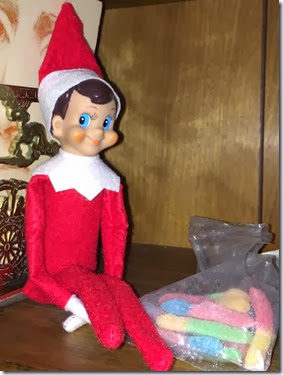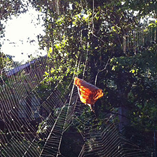In the forty-two years of America’s Drug War, we’ve – you, me, all the taxpayers alive and dead in those years – have spent, are you ready, $1012.
Ten to the twelfth power; a one and twelve zeroes; $1 trillion. We’re at a number that when many of us were born, few had heard of it.
. . . .The July 18, 2013, post to Spittin’ Grits
Thanks to the artist at pagetutor.com, here is what $1 million looks like in $100 bills:

Next tax day, when you’ve got an amount you owe on taxes, why not sit and wonder how much you’ve paid since 1971 toward the Drug War’s $1 trillion tab. How much will you continue to pay on the nearly$52 billion a year?
And now, drumroll, he presents $1 trillion in $100 bills. See the guy in the red shirt above? Notice the same guy in the red shirt on the lower left at the red arrow below.

How did the American War on Drugs come to this?
When President Richard M. Nixon announced his “new, all-out offensive” in 1971 and pronounced it “public enemy number one,” he in essence criminalized this new version of drug use in America. By golly, drug fiends weren’t going to get away with it. We’d throw them all in jail.I don’t know what Nixon’s grades were in his history classes, but the irony was then and is now that we had already done this once and, boy, did that effort crash and burn. It was called Prohibition. About the only good thing to come of it, besides the “Roaring Twenties” response to outlawed booze, was the great movies and television shows about Eliot Ness and his efforts to enforce the laws prohibiting alcohol, fight with Al Capone, and save the U.S. from its devastating alcohol use. I doubt I ever missed an episode of The Untouchables with Robert Stack. What a hunk he was. The series started in 1959 and ran for four years and 119 episodes.
Then Brian De Palma directed the 1987 movie The Untouchables with a whole host of hunks – Kevin Costner, Sean Connery, Robert De Niro, Andy Garcia, and others.
Remedial History 101
Criminalization/militarization of an effort is EXPENSIVE, but history lessons be damned. First, in the initial 25 years of the Drug War, the U.S. in its desperation and devotion to the “tough on crime” ideology, passed and implemented hard-nosed anti-drug laws; in turn, state law enforcement offices and personnel had to be outfitted to handle the crime wave. Law enforcement became more and more “militarized.” If you think that must have been expensive, just wait.
Blast Furnace Down
Second, Nixon’s criminalization of drug use finally transformed into an all-out war, with other nations (some being homes to cartels of suppliers) getting involved. War requires the military. And military we got. The militarization of the Drug War began in 1986 with 160 American soldiers, each with an M-16 rifle, a big cargo transport plane filled with Black Hawk helicopters, another with troop planes, landing in Bolivia to carry out Operation Blast Furnace. The mission was to burn plants and cocaine labs and to seize a bunch of money and weapons belonging to drug smugglers, and blah, blah, blah. It fizzled. The drug kingpins knew the Dogs of War were coming and, poof, the bad guys were gone.

Since then, the U.S. has thrown at America’s drug problem and war our entire military arsenal short of the atom bomb. The arsenal has included Captain America, and most recently, drones.
Drugs on the Moon?
The rest of the story of the mega-militarization of the Drug War continues to be comic book material. Except that it is and has been such a pathetic attempt to stop the very War it feeds.
This past spring, the international edition of Spiegel Online presented a five-part series about the global Drug War, beginning with an interview with Pablo Escobar’s right-hand man, Popeye. Only a psychopath could love it; it’s scary and horrible.
Popeye explains to the writer about shooting people:
You can survive one shot, but never two. I cut up the bodies and threw them in the river. Or I just left them there. I often drove through Medellín, where I kidnapped and raped women. Then I shot them and threw them in the trash. . . . I've killed about 250 people, and I cut many of them into pieces. But I don't know exactly how many. Only psychopaths count their kills.
The writer calls the interview “opening the door to Hell.” But Popeye does explain why you can’t stop people like him:
People like me can't be stopped. It's a war. They lose men, and we lose men. They lose their scruples, and we never had any. In the end, you'll even blow up an aircraft because you believe the Colombian president is on board. I don't know what you have to do. Maybe sell cocaine in pharmacies. I've been in prison for 20 years, but you will never win this war when there is so much money to me made. Never.
In a later part of the series and after having researched and interviewed, the writers are told why not even the military can stop this War:
The best way to imagine the drug war is as a never-ending arms race. The customs agents are given psychological training. The drug cartels have schools for their smugglers. The coast guard is given speedboats that can travel at 50 knots. The dealers buy boats that can go 60 knots. The navy patrols in the Pacific. The dealers build submarines that can cover 5,000 kilometers (3,100 miles) without surfacing. The drug war expands with each new battle. If there were demand for drugs on the moon, the launch of the first cocaine rocket would probably be imminent.
Cold War II – Run Amuck
So what we have here is the philosophy of the Cold War with Russia, mutually assured destruction, with a twist: the joke this time will be on the U.S. The domestic and international militarization of law enforcement is the most expensive slice of the Drug War pie. And it’s all for naught.
A recent Associated Press story examined U.S. arms export authorizations, defense contracts, military aid, and exercises in the region.
In the most expensive initiative in Latin America since the Cold War, the U.S. has militarized the battle against the traffickers, spending more than $20 billion in the past decade. U.S. Army troops, Air Force pilots and Navy ships outfitted with Coast Guard counter-narcotics teams are routinely deployed to chase, track and capture drug smugglers.
The story reported on:
l $2.8 billion worth of guns, satellites, radar equipment and tear gas going to Western Hemisphere nations in 2011
l defense contracts that jumped from $119 million to $629 million, “supporting everything from Kevlar helmets for the Mexican army to building airport runways in Aruba
l $830 million, almost $9 out of every $10 of U.S. law enforcement and military aid spent in the region, for countering narcotics
Scarface, Jr.
Whatever the total cost or annual cost for the domestic and international militarization of the Drug War – and maybe we can’t really know – continuing the same efforts is getting crazier. Two pieces of recent information, déjà vu all over again, would be crazy if they weren’t scary.
First, remember that the primary route for drugs into the U.S. from South America, particularly Columbia, used to be through Miami. That fact created a lot of stories for the entertainment industry, the worst/best of which was Bran De Palma’s Scarface, written by Oliver Stone and starring Al Pacino; no wonder it was one of the worst/best, with those names involved.
Next, remember (if you’re old enough) these 30-year-old names and words: Nicaragua, Sandinistas, President Ortega, and Russia. Well, they’re baaaaaack.
An April Time International on-line piece reported that the good news for Nicaraguans is that they’re renewing a relationship with Russia, which is supplying millions of dollars for military stuff targeted at drug traffickers.
Here’s what a high ranking state department official said about this development:
The truth is that we want collaboration, and if the collaboration comes from Russia in our hemisphere or if it’s the United States in Russia’s hemisphere, then I think that is positive,” Assistant Secretary of State William Brownfield, the Obama Administration’s point man on Central America’s drug war, said in response to Russian drug czar Victor Ivanov’s recent visit to Nicaragua.
Am I nuts or does this sound like something off The Colbert Report on Comedy Central?
As for the drug route: Brownfield says that as we put the squeeze on Central America, the cartels will feel the pressure and decide to route their goods to Europe.
WHAT??? And turn their backs on the U.S. market? What kind of business school did Brownfield attend?
Furthermore, he says, “last year about 9 percent of all illicit drugs that entered the United States came from the Caribbean, compared to about 4 or 5 percent in 2011,” and “logic suggests drug cartels will return to trafficking routes used during the 1980s and 1990s.”
Get ready, Hollywood.
So, let me get this straight: After spending $1 trillion toward America’s War on Drugs, most of which is spent to militarize domestic and international law enforcement, we will have come full circle in pressuring the cartels to move their drug route back to Florida. I think I’ll check my tax return from last year and figure out how much I paid to this insanity.
 I noticed that Joanna Leigh is bribing her Elf with candy before he leaves for the North Pole tonight.
I noticed that Joanna Leigh is bribing her Elf with candy before he leaves for the North Pole tonight. 


























![[IMG_0866%255B7%255D.jpg]](http://lh4.ggpht.com/-miSakcRZfGc/UlB5vrMdc0I/AAAAAAAADtE/5Ueojok2HH8/s320/IMG_0866%25255B7%25255D.jpg)






